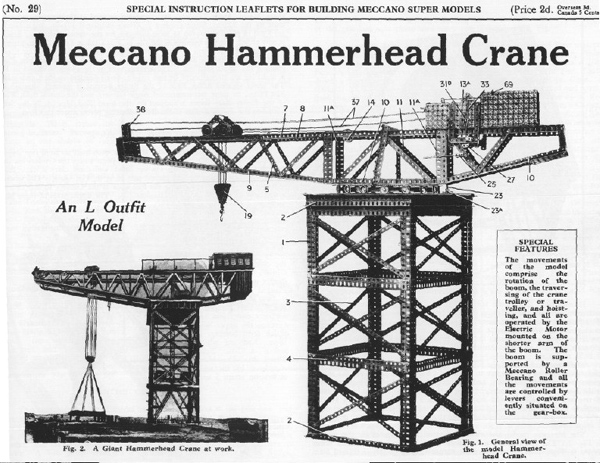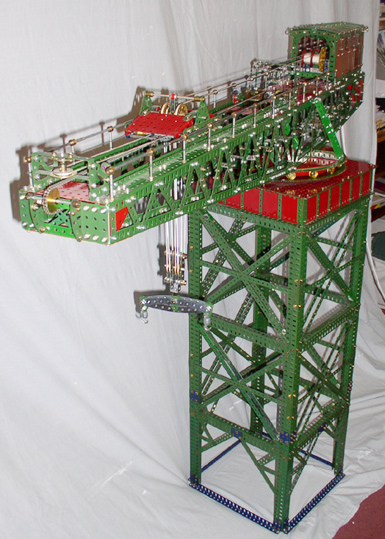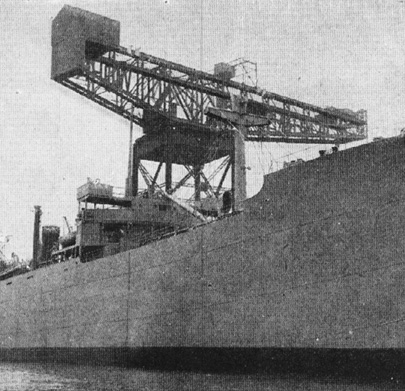

 |
The model is one of only a handful of designs Meccano published that used part no. 167 the geared roller bearing. This was the largest and most expensive part produced by the company. Introduced in 1928 it was never a big seller, priced at £1.00 it was a very expensive part. Most of the published plans using the G.R.B. were in fact reworking of models designed earlier that used a roller bearing made up from part No. 119 channel segment. Production of the G.R.B. ended with wartime regulations in 1941 along with that of all other Meccano products. The G.R.B. was unfortunately not in the range of parts when production resumed in 1945. The one I used on the crane is a modern reproduction made by Ashok Banerjee and finished in 1950s red and green. I did intend when I started construction to build the model as illustrated but decided the design of the boom was too simplistic compared to the prototype cranes. In fact the "L outfit" had many more parts than the instructions used and a much better model could have been designed.
My model is not a scale model but based on the proportions of the original Meccano model and various pictures of the original cranes. I also used the basic design and construction of the boom from Bert Love's Electric Dockside Crane published in The Meccano Magazine, in two parts, July and October 1978. The main difference being I continued the double bracing throughout the entire length of the boom the original crane was designs to built with the parts in the Number 10 set. The boom is balanced with 1.5 kg. of cast lead weights. The model is driven by three electric motors, one for each of the movements, Slewing, hoist and crab trolley. Again I followed Bert's design for the hoist and trolley. The slewing movement is driven by a Swiss Escap motor with built in reduction gearing driving directly through connecting drive shafts to the spur gear rotating around the geared roller bearing. The motive power of the original cranes would also have been electric motors.
The picture below is from a wartime publication "Britain's Merchant Navy" circa 1943 and shows a hammer head crane at a fitting out yard where pre-fabricated (Liberty) ships were assembled.
The photograph above is of the 250 tonne hammer head crane at the Captain Cook dry dock in Sydney. The crane took six years to build and was completed in 1952. The main boom is 83 metres (273 ft.) long. The tower is 43 metres (141 ft.) high from dockside to the underside of the boom and is 15.25 metres (50 ft. ) square. The tower rests on foundations 27.4 metres (90 ft.) below the sea bed. During the trial erection, the cantilever boom was assembled upside down this was done to avoid the great deal of shoring that would have been necessary because of the tapering of the cantilever. I built the boom in the same way on my model. I shot the picture in the early morning of March 19 2002 on the first day of an Australian holiday. The crane on the left is the 80 ton crane at Cowes on the Isle of Wight. The crane was designed and engineered by Babcock and Wilcox in 1911 and was the only crane of this type they ever built. It is one of the earliest cranes of this type still existing. I took the photograph in the late afternoon, April 2005. For more information about The Cowes Giant Cantilever Crane click here. |
| The completed Meccano crane pictures were taken January 21 2004 page revised October 03 2009 |
 This model is very loosely based on the Meccano Super Model leaflet Number 29 published in 1934, the cover of which is shown on the left .
This model is very loosely based on the Meccano Super Model leaflet Number 29 published in 1934, the cover of which is shown on the left . 

 The prototypes of this type of crane were built between the 1900s - 1970s and can still seen be at navel dockyards and ship builders around the world. Although referred to as "Hammer Head Cranes" the more correct term would be a "Giant Cantilever Crane". There are fine examples on Clydeside, Cowes, Halifax Nova Scotia and Sydney Australia. They were designed to be used for very heavy lifting during the fittingly out and repair of large ships. Many of the cranes were capable of lifts of over 250 tonnes. Their use was some what restricted as they were built in a fixed position on the dock side. The black and white picture (right) is the Govan shipyard crane, Glasgow one of five cranes of this type on the Clyde.
The prototypes of this type of crane were built between the 1900s - 1970s and can still seen be at navel dockyards and ship builders around the world. Although referred to as "Hammer Head Cranes" the more correct term would be a "Giant Cantilever Crane". There are fine examples on Clydeside, Cowes, Halifax Nova Scotia and Sydney Australia. They were designed to be used for very heavy lifting during the fittingly out and repair of large ships. Many of the cranes were capable of lifts of over 250 tonnes. Their use was some what restricted as they were built in a fixed position on the dock side. The black and white picture (right) is the Govan shipyard crane, Glasgow one of five cranes of this type on the Clyde. 

